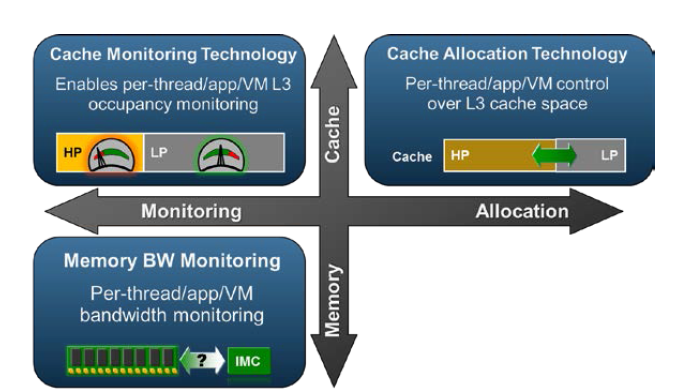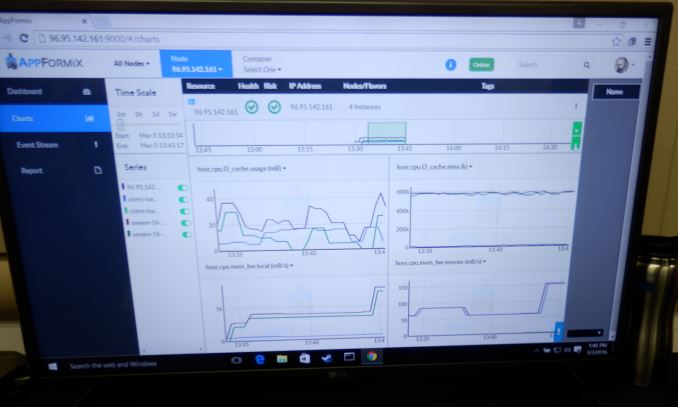The Intel Xeon E5 v4 Review: Testing Broadwell-EP With Demanding Server Workloads
by Johan De Gelas on March 31, 2016 12:30 PM EST- Posted in
- CPUs
- Intel
- Xeon
- Enterprise
- Enterprise CPUs
- Broadwell
Sharing Cache and Memory Resources
In a virtualized environment, the hosted VMs are sharing both the CPU caches and the overall DRAM memory bandwidth. One cache-hungry application can quickly hog most of the shared L3 caches, and a bandwidth intensive one can do the same with the available and shared memory bandwidth. These VMs create the "noisy neighbor" problem. That is bad news for anyone consolidating a lot of VMs on top of a Xeon server, but it is complete show stopper for telco and other scenarios where service providers want to guarantee "Quality-of-Service" (QoS) and thus predictable latency. For Intel this is a notable scenario to address, as the telco market is one of the few markets where the Xeons still have some room to grow. Many telco applications still run on proprietary boxes, which makes virtualization a tantalizing option if Intel can deliver the necessary latency.
Haswell had already some features to monitor cache usage, which in turn allowed you to identify the noisy neighbors. However the "Resource Director Technology" (RDT) of Broadwell can do a lot more.
RDT can not only monitor L3 cache usage and memory bandwidth, but it can also allocate L3-cache space on a per thread/process/virtual machine basis. Threads are assigned a Resource Monitoring ID. Eight of these RMID are available per core/cache slice. Sixteen different classes of service can be assigned to an RMID: higher priority threads/applications can get a higher class, and thus a larger portion of the L3-cache.
Intel has already demonstrated an application that made use of these new MSRs to read out memory bandwidth and L3 cache consumption on different levels.












112 Comments
View All Comments
jhh - Thursday, March 31, 2016 - link
The article says TSX-NI is supported on the E5, but if one looks at Intel ARK, it say it's not. Do the processors say they support TSX-NI? Or is this another one of the things which will be left for the E7?JohanAnandtech - Friday, April 1, 2016 - link
Intel's official slides say: "supports TSX". All SKUs, no exceptions.Oxford Guy - Thursday, March 31, 2016 - link
Bigger, badder, still obsolete cores.patrickjp93 - Friday, April 1, 2016 - link
Obsolete? Troll.Oxford Guy - Tuesday, April 5, 2016 - link
Unlike you, propagandist, I know what Skylake is.benzosaurus - Thursday, March 31, 2016 - link
"You can replace a dual Xeon 5680 with one Xeon E5-2699 v4 and almost double your performance while halving the CPU power consumption."I mean you can, but you can buy 4 X5680s for a quarter the price of a single E5-2699v4. It takes a lot of power savings to make that worthwhile. The pricing in the server market's always seemed weirdly non-linear to me.
warreo - Friday, April 1, 2016 - link
Presumably, it's not just about TCO. Space is at a premium in a datacenter, and so being able to fit more performance per sq ft also warrants a higher price, just like how notebook parts have historically been more expensive than their desktop equivalents.ShieTar - Friday, April 1, 2016 - link
But you don't get 4 1366-Systems for the price of one 2011-3 System. Depending on your Memory, Storage and Interconnect Needs, even two full Systems based on the Xeon 5680 may cost you more than one system based on the E5-2699 v4. One less Infiniband-Adapter can easily save you 500$ in Hardware.And you are not only halving the CPU power consumption, but also the power consumption of the rest of the system that you no longer use, so instead of 140W you are saving probably at least 200W per System, which can already add up to more than 1k$ in electricity and cooling bills for a 24/7 machine running for 3 years.
And last, but by no means least, less parts means less space, less chance for failure, less maintenance effort. If you happily waste a few hours here or there to maintain your own workstation, you don't do the math, but if you have to pay somebody to do it, salaries matter quickly. With an MTBF for an entire server rarely being much higher than 40.000, and recovery/repair easily taking you a person-day of work, each system generates about 1.7 hours of work per year. Cost of work (it's more than salaries, of course) probably comes up to 100$ for a skilled technical administrator, thus producing another 500$ over 3 years of added operational cost.
And of course, space matters as well. If your data center is filled, it can be more cost effective to replace the old CPUs with new expensive ones, rather than build a new facility to fill with more old Systems.
If you add it all up, I doubt you can get a System with an Xeon 5680 and operate it over 3 years for anything below 20.000$. So going from two 20.000$-Systems to a single 24.000$ Dollar System (because of an extra 4000$ for the big CPU) should save you a lot of money in the long run.
JohanAnandtech - Friday, April 1, 2016 - link
Where do you get your pricing info from? I can not imagine that server vendors still sell X5680s.extide - Friday, April 1, 2016 - link
Yeah, if you go used. No enterprise sysadmin worth his salt is ever going to put used gear that is not in warranty, and in support into production.